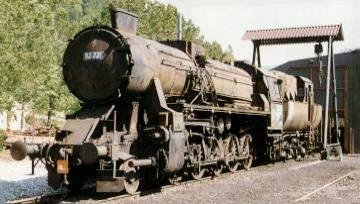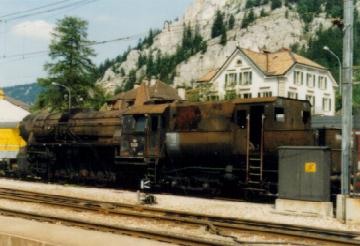

| Builder | Berliner Maschinenfabrik |
| Year built | 1943 |
| Works number | 12226 |
| Weight in working order | 149,7 tonnes |
| Length over body | 22 975 mm (75 feet, 4 inches) |
| Maximum speed | 80 km/h (44 mph) |
| Boiler pressure | 16 bar (240 psi) |
| Power | 1620 CV |
| Grate area | 3,9 m˛ (41,9 sq.ft.) |
| Driving wheel diameter | 1400 mm |
| Fuel capacity | Coal
- 10 tonnes. Water - 26 m3 (5'715 gallons) |
| Other informations | french
: http://www.voisin.ch/dlok/br52_f.html german : http://www.dlok.de/98.thm |

 |
Origin :
The great need for locomotives in Germany during the second world war explains the explosion in production. First of all construction of classes 44, 50 and 86 was simplified (for example, smoke deflectors missing, only one side window in the cab on certain machines), and orders for other types of locos were cancelled.
The best loco of the war was the class BR 50. The construction of the Class BR 52 was not foreseen in any construction program, never mind that of 1939. In 1941 the need for a new simpler type was apparent. These machines became, with an axle load of 15 tonnes and a maximum speed of 80 km/h (44 mph) forwards or backwards, as good as the Class BR 50. Significant quantities of materials and manpower were able to be reduced further reducing their cost.
The Class BR 50 was simplified, of 6000 locos built during peacetime only 5000 were now necessary, of which 3000 were simplified so much that the weight of the loco and tender fell from 165 tonnes to 139 tonnes ( from 1943 - 130 tonnes). It was possible to save 6000 hours of work by machine.
The development of the Class 50 into the Class 52 was in a progressive manner, in order to avoid interruptions to production. The first Class BR 52 locos could not be distinguished from a Class BR 50 except by their distribution - all the other locos were as common as the Class BR 50Ük.
270 locos ordered to the Class BR 50 Uk design were numbered as Class BR 52, for example 50 2773 to 2777 built by Henschel were renumbered as 52 002 to 52 006. This explains why Class BR52 was constructed with a lighter weight chassis.
The most significant modifications were suppression of feed water heater , smoke deflectors, (reinstated after the war), and the sloping front framing. The abandonment of axle box adjustment was quickly found to be a mistake, as axle box wear increased. The feed pump to the pistons was replaced by a second injector and the massive chassis by a lighter chassis ( the chassis alone allowed a weight saving of 5000 kilos of steel). The connecting rods were laminated into a double T profile, welded - which was very controversial as no-one had any experience of the life of this type of rod. In fact, these locos were in service with this type of rod until the end of their working life between 1970 and 1980. One novelty of the construction of these German locos was the enclosed driving cab because of the severe winters in the east.
So as to maximize the propaganda of the productivity gains, it was decided (only in June 1942) to give this series of simplified locos the number series 52. 52 001 - officially the first loco of the 52 series was delivered in September 1942, then sent on a publicity tour.
The economies of copper and tin, commended by those in charge was, contrary to the beliefs of the propaganda merchants as demonstrated by skilful engineers. Thus, those in charge announced the use of 2,358 kilos of copper and 450 kilos of tin for each Class BR 50. One Class BR 52 only used 126 kilos of copper and 23.5 kilos of tin. The greatest economy was in the firebox as the BR 50 had from the start, like the BR52 a steel firebox. It was the same for the economies of tin, the BR 50 had been equipped for a long time with a regular level.
The locos of the Class BR 52 series were for the most part coupled with K 2'2' T 30 "bathtub" tenders, constructed previously with the Class BR 50 series tenders. The rigid wheelbase tender K 4 T 30 developed by Rax was unsatisfactory when the loco was running tender first. The "bathtub" tenders , derived form the american Vanderbilt tenders, were in fact developed for the 01.10 series and distinguished themselves by having a running weight of only 18.5 tonnes.
Having been simplified, production could be increased. Despite this , the loco industry never achieved it's planned numbers. The total number of Class BR 52 locos constructed differs between sources. One reliable source quotes a total of 6,719 locos, another as many as 6,942. The Class BR 52 is in any case, the largest series of Germans locos, which being mass produced with an expected life of 5 years are still working more than 40 years after some of their companies.
Supplementary information : The Class BR 52 after the war
This picture from Tigerli and BR52 is from http://www.mediatime.ch/bahn/
The 52 221
Built by BMAG (ex S chwarzkopf) for the DRG, 52 221 stayed with the OBB in 1945, where it received a Giesl ejector, and a cab tender, as 152 221 until it was renumbered back to it's original number in 1963. After having been reviewed in 1975 by OBB, this machine this machine stored for 4 years as part of the "strategic reserve". Oswald Steam purchased this loco in working order on the 15th November 1979. The loco was then shedded at Samstagern, then outside at Einsiedeln until the VVT took it back in July 1992. This explains the locos shabby appearance, which contrasts with it's good mechanicl condition.
Remedial work on this loco has begun. Before completely stripping the loco down, we have chosen a step by step solution, allowing the loco to be seen at all times.
The objective for 2001 was to complete the left hand cylinder, and to Giesl chimney which is in a poor condition, (for which there is no replacement), then to replace the chimney with a round one to the original design. In the winter of 2003 the boiler was lifted from the chassis to enable restoration work to continue.
The Family Sandoz Foundation gave us the financial possibility for a general overhaul in Ceske Velenice. The BR52 221, the boiler of the Slask and the axle of the B2 333 were sent on the 28th of August 2006 and the repairs will be completed for autumn 2007. The virtual visit of these works begins here. Pictures from the overhaul are on the official page of the VVT.
You can visit the Works of Ceske Velenice ... or a page with pictures from the back-trip from the 52 221 on Saturday, the 28th October 2007.
http://www.voisin.ch/vvt/ : 22.03.2008